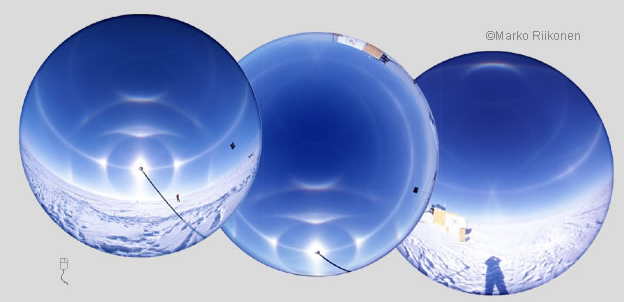South Pole Halo Display
Exploring the Enchanting South Pole Halo Display
When it comes to halo displays, the polar regions offer a truly mesmerizing spectacle. While fine halo displays can be witnessed all over the world, the South Pole is known for its exquisite and extraordinary displays. One such display was captured by Marko Riikonen, a Finnish researcher, during the Antarctic summer of 1998/1999. Together with Jarmo Moilanen and Marko Pekkola, Riikonen documented a remarkable halo display formed by low-level diamond dust ice crystals that lasted an astonishing 50 minutes.
The images captured by Marko Riikonen provide a fascinating glimpse into the sunwards sky, the entire sky centered on the zenith, and the halos in the anthelic direction opposite the sun. The photographs showcase a multitude of rare arcs, with those from Parry oriented crystals being among the most exceptional ever documented. Riikonen's fisheye images offer a unique perspective, inviting us to delve deeper into the captivating phenomenon that unfolded during those 50 minutes.
To truly appreciate and understand the South Pole halo display, it is essential to embark on a long and meticulous study of what occurred during that brief period. Each halo visible in the images holds its own significance and contributes to the overall beauty of the display. By hovering over the "Halo key," one can identify and explore the individual halos, unraveling their intricacies and marveling at their unique characteristics.
The South Pole halo display serves as a testament to the awe-inspiring wonders of atmospheric optics. It showcases nature's ability to create mesmerizing optical phenomena through the interaction of sunlight with ice crystals suspended in the atmosphere. As sunlight passes through these ice crystals, it undergoes refraction and reflection, resulting in the formation of intricate halos, arcs, and other ethereal atmospheric effects.
The diamond dust ice crystals responsible for the South Pole halo display are particularly noteworthy. These small, plate-like crystals are shaped like flat hexagons and can be found close to the ground. Their unique structure and orientation play a crucial role in the formation of the various halos observed in the display. The Parry oriented crystals, in particular, contribute to the exceptional quality of the arcs captured by Riikonen's photographs.
The South Pole halo display is just one example of the remarkable atmospheric phenomena that occur in polar regions. Due to their unique climatic conditions, these regions offer an ideal environment for the formation of intricate halos and other optical wonders. The extreme cold temperatures and abundant ice crystals create a perfect stage for the interplay of light and ice, resulting in displays that are truly unparalleled.
In conclusion, the South Pole halo display captured by Marko Riikonen stands as a testament to the extraordinary beauty and complexity of atmospheric optics. Through his photographs, we are transported to a world where sunlight dances with ice crystals, giving rise to a spectacle that captivates the imagination. By studying these images and delving deeper into the intricacies of each halo, we gain a deeper appreciation for the wonders that unfold above us in the polar regions. The South Pole halo display serves as a reminder of the enchanting and ever-surprising nature of our atmosphere, always ready to astound us with its ethereal displays.

Fine halo displays occur all over the world but the polar regions get the really exquisite ones.
Marko Riikonen of Finland photographed this extraordinary display while researching halos at the South Pole during the Antarctic summer of 98/99 together with Jarmo Moilanen and Marko Pekkola. The great January 11th display was formed by low level diamond dust ice crystals and lasted 50 minutes. There were a great many rare arcs and those from Parry oriented crystals were among the best, if not the best, ever photographed.
Marko Riikonen's three fisheye images capture the sunwards sky, the whole sky centered on the zenith and halos in the anthelic direction opposite the sun. Larger images are on the next three pages. What happened in those 50 minutes is worth long and careful study. Mouse over the "Halo key" to identify the individual halos.
All the South Pole images ©Marko Riikonen, shown with permission.
Note: this article has been automatically converted from the old site and may not appear as intended. You can find the original article here.
Reference Atmospheric Optics
If you use any of the definitions, information, or data presented on Atmospheric Optics, please copy the link or reference below to properly credit us as the reference source. Thank you!
-
<a href="https://atoptics.co.uk/blog/south-pole-halo-display/">South Pole Halo Display</a>
-
"South Pole Halo Display". Atmospheric Optics. Accessed on November 21, 2024. https://atoptics.co.uk/blog/south-pole-halo-display/.
-
"South Pole Halo Display". Atmospheric Optics, https://atoptics.co.uk/blog/south-pole-halo-display/. Accessed 21 November, 2024
-
South Pole Halo Display. Atmospheric Optics. Retrieved from https://atoptics.co.uk/blog/south-pole-halo-display/.